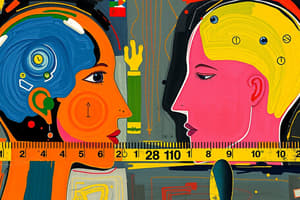Podcast
Questions and Answers
What is the biopsychosocial model, and what are its components?
What is the biopsychosocial model, and what are its components?
The biopsychosocial model is a framework for understanding human behavior and personality. It consists of three components: biological (genetic and physiological), psychological (affective, behavioral, and cognitive), and social (socio-economic, socio-environmental, and cultural) factors.
What is the difference between traits and states, and how do they relate to personality?
What is the difference between traits and states, and how do they relate to personality?
Traits refer to relatively stable patterns of thought, feeling, and behavior that distinguish an individual, whereas states are transient and context-dependent. Traits are enduring, while states are influenced by the situation.
What is the power of the situation, and how does it relate to trait consistency?
What is the power of the situation, and how does it relate to trait consistency?
The power of the situation refers to the idea that an individual's behavior is often determined more by the situation they are in than by their traits, leading to low trait consistency across situations.
What is self-monitoring, and how does it relate to trait consistency?
What is self-monitoring, and how does it relate to trait consistency?
What is the purpose of psycho-metry in understanding personality?
What is the purpose of psycho-metry in understanding personality?
What is the lexical hypothesis and how does it relate to personality traits?
What is the lexical hypothesis and how does it relate to personality traits?
What are the Big Five dimensions of personality, and what do they represent?
What are the Big Five dimensions of personality, and what do they represent?
What is the difference between introverts and extroverts, and how does it relate to the Reticular Activating System?
What is the difference between introverts and extroverts, and how does it relate to the Reticular Activating System?
What is the role of genetics in personality, and how do twin studies support this?
What is the role of genetics in personality, and how do twin studies support this?
What is the psychoanalytic perspective on personality, and how does it relate to defense mechanisms?
What is the psychoanalytic perspective on personality, and how does it relate to defense mechanisms?
Flashcards are hidden until you start studying





